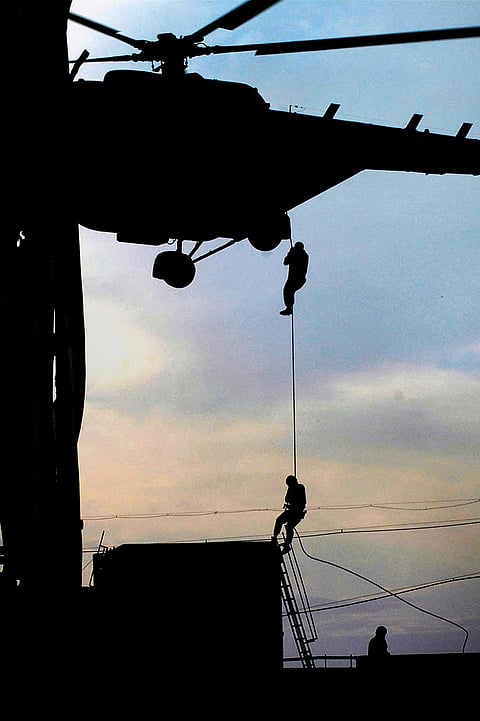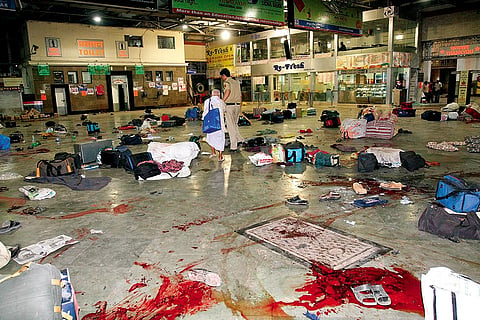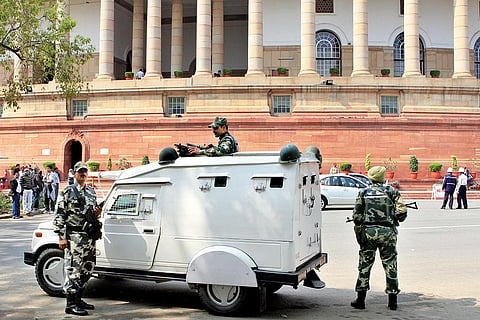War today has mutated; it now comes in many forms. Once it used to have a beginning and an end—truce and peace would follow war. Terrorism, its most dreaded modern mutant, breaks that template. It has the feel of a permanent war, one without end or armistice. November 26 is a day to remember one of the biggest terror strikes India has seen—big on spectacle like 9/11, and almost equal in its disruptive nature, if not the number of people who lay dead at the end. One decade since that November day, it’s a time to mourn the dead—a staggering 166 civilians and security personnel—and to take what appears in the retrospective lens and apply it to the future. The best way to honour those dead would be to ensure the mistakes that brought it about, or aided it, are never repeated. Are we ready to face a new, morphed form of violent terror? Before we look at the gaps in our fences, we must crack the code of terror, put its Rubik’s cube squares in a pattern.
To Stop The Next Kasabs: 10 Years After 26/11, Is India Any Safer?
The 26/11 frame is an apt one to survey and take stock of India’s readiness and/or vulnerabilities today. Sheer shock and awe ensured it was a day of reckoning for India’s internal security apparatus: its strengths and weaknesses were on public display.
Each terror strike is an act of war in miniature. Like everything getting smaller and more effective—electronic gadgets, polluting particles like PM2.5, lynchings instead of riots—terror too offers a bonzai war entering everywhere and ever-present. It invades the public arena; every civilian is a target. But compared to the many other terror strikes India has witnessed, 26/11 was the true Black Swan event in its sheer atypical brazenness. Instead of surreptitiously placed bombs, it was a rain of randomly sprayed bullets that felled its victims. The small kamikaze band of ten who sailed from Karachi and erupted on a Mumbai night with AK-47s, grenades, RDX and sophisticated satphones resembled nothing more than a real invasion, even if on a micro scale. The apparently unsynchronised bullets had an architect’s master design tracing their trajectories. The targets were, symbolically, chosen according to the pet hates of the Lashkar-e-Toiba and its ‘global jehad’: India, Israel, US, European countries that had participated in the Iraq war et al. The many innocent Muslims who too lay dead at CST rail terminus were merely collateral damage—of a piece with the omnivorous pattern of modern terror.
The 26/11 frame is an apt one to survey and take stock of India’s readiness and/or vulnerabilities today. Sheer shock and awe ensured it was a day of reckoning for India’s internal security apparatus: its strengths and weaknesses were on public display. The biggest lacuna, of course, was in intelligence (see ‘When FBI Killed Naipaul a Decade Before He Died’)—those gaps let 26/11 happen in the first place. The event’s first draughtsman, a half-white with eyes of different colours, had made several trips to Mumbai without agencies getting wind of what he was up to. David Coleman Headley, a US Drug Enforcement Administration (DEA) agent apparently gone rogue, had reconnoitered and mapped the arena, and zeroed in on the five high-impact locations the sea-borne terrorists finally fanned out to (see timeline). Later investigation revealed that less than half of the actions chalked out in the original plans could actually be carried out.

India’s intelligence capabilities, despite attempts to integrate them, are still fragmented and subject to the same frailties. A scattered response, in real time, would still hobble our defences. The NSG, our specialised anti-terror sword-arm, had then scored spectacular successes at the end of three days. But it arrived six hours after the first shot—after failed attempts by the Maharashtra Police’s anti-terror squad (ATS). Brigadier (retd) Govind Sisodia, who led those operations, is eager to dispel any thought of tardiness. “First, the state deploys its own resources. If it’s beyond the state’s capacity to handle, then the NSG is called in,” he explains. “On 26/11, there were reports of gunfire so it was thought to be a gang war. Once they realised it was a terror strike, they deployed the Maharashtra ATS. The entire Mumbai police force was out that night, especially its officers, some of whom were killed. You have to understand, the state police is for law and order, not anti-terror ops.” Still, even an hour’s gap in response to a terror situation, due to protocol, is too long.
Especially if we consider some key elements that created the surprise factor. Some still hold—for instance, the novelty of the sea route. (A Pakistani boat infiltrated Indian waters, hijacked an Indian ship and used a speedboat to sail into a fishing village in Mumbai’s harbour.) For another, terror is a constantly evolving beast. After the attack, Mumbai resumed its high-paced life and politicians resigned or shuffled portfolios. But have the gaps in intelligence, coastal security and police capabilities been fixed? Our reportage reveals the NSG, the sharpest of all, has upped its game considerably, and also, to an extent, those taking care of coastal security. But large gaps remain in state police and intelligence capabilities.
Intelligence
Headley wasn’t on any watchlist. No ‘Black List’ or ‘Prior Approval Category’ boxes were ticked. No one knew he existed. Most spooks agree it will be next to impossible to stop the next Headley. A visa won’t be refused unless an applicant is on a watchlist. Nor can sleuths posted in missions abroad help unless a future Headley is already under watch by foreign agencies or Interpol. Even countries like the US or the UK can’t detect a lone wolf with a clean slate.

NSG commandos during the operation at Mumbai’s Nariman House
Did the US fail to let on vital facts to an ally like India? “Headley was not on any US suspect list,” says former special secretary (cabinet secretariat) V. Balachandran. “He was a rogue DEA agent. Only his frequent India trips in September 2006, February/September 2007 and April/July 2008 could have aroused our suspicion. But businessmen do travel frequently, and unless he was shadowed closely in Mumbai, his activities would not have been detected. Our internal intelligence agencies failed to do that.” To be sure, there were stray intelligence inputs on Headley to the FBI, such as his spying on a Danish newspaper. But the FBI was barred by US law from asking DEA for details on one of its agents.
What about us? India responded to 26/11 by forming NatGrid—a national grid of intelligence agencies—to serve as a platform for information-sharing and coordination. “But, no agency wants to give up control over its domain, especially the Intelligence Bureau,” says a former MHA official. “The IB has failed to reinvent itself because of its structure. It still focuses more on assessments and strategic intelligence gathering. Instead, it needs to focus on tactical intelligence such as undercover operations.”
Even after NatGrid, India saw terror attacks on Gurdaspur and Pathankot. And there is no definite evidence yet as to how they were planned. “In the realm of terror ops, intelligence holds the key,” says former IPS officer Y.P. Singh. “It’s worrisome. We have not even been able to set up a National Counter-Terrorism Centre because of lack of cooperation from the states.” Enough holes there for a Headley (or a speedboat) to snake through.

Coastal Security
The sea is the great unknown. Most landlocked Indians don’t realise the country’s borders are also coastal—over 7,516 km of open waters. What does a micro-picture look like? Well, India’s western seas have at least 50,000 vessels, including a large number of fishing boats, on it at any given time; the eastern side has around 25,000. What are the chances of a speedboat or two (or something else) sneaking through? It was high in 2008. There was no system of cooperation and sharing between the Navy, Coast Guard and state maritime police forces, each with its own jurisdiction (see infograph). Now the chances are less, but it’s still not zero.

“It will be difficult to penetrate the systems now, but 100 per cent can’t be ensured,” says Vice Admiral (retd) Shekhar Sinha. “If everything promulgated since 26/11 is complied with, coastal security will be better.” The Navy now commands joint operation centres (JOCs), working with the Coast Guard and maritime police. Surveillance is a joint responsibility. The Navy’s ships, submarines and planes—and its sonar and radar systems—are on perpetual vigil. Multiple agencies intercept satphone calls from ships. In almost all coastal states, fishermen double up as intelligence eyes—villages now have hotlines to JOCs. All results are shared.
The Tamil Nadu Police was the first to form its own coastal security wing in the 1990s, headed by an IG. All police stations along the coast come under its purview. Fishing hamlets and the Coast Guard, all participate in this buzzing grid. Kerala joined in too. “In the past 10 years, our fishermen began to inform police about any suspicious movement of foreign vessels,” says former Kerala DGP Jacob Punnoose. “The Italian ship Enrica Lexie and others were intercepted because of this rapport.”
The system isn’t foolproof, though. Boats of all states are supposed to be colour-coded. Also, they are meant to be compulsorily fitted with a DRDO-developed, smaller version of the Automatic Identification System (AIS) that’s on ships weighing above 300 tonnes, relayed to surface radars on the shore. Except for in Gujarat and TN, compliance of norms is low, including in Maharashtra. (Tamil Nadu also uses a diesel subsidy to ensure compliance.)
Everyone on board smaller craft, mostly the fishing boats, is also supposed to have biometric identification. But it’s usual for only the pilot to have one; many of the labourers are ID-less contract workers. “The fishing communities are major votebanks and no politician will disturb them. Besides, there aren’t enough biometric ID readers for the Coast Guard or maritime police,” says a Navy official. “Coastal security still operates under an executive order and has to be made into a law.”
Evolution Of Terror
All this while, terrorist capabilities have been getting upgraded. Their arsenal could now include elements such as chemical weapons and drones, besides communication capacities that enable attacks of the sort one saw during 26/11, Gurdaspur or Pathankot. The threat itself has been redefined. A new set of targets have emerged—national assets such as nuclear and petrochemical assets, or security installations such as the air base in Pathankot (or even within Pakistan). A petrochemical plant contains hydrogen sulphide, the release of which by a terror attack can cause a Bhopal-like tragedy.

Mumbai’s Chhatrapati Shivaji Terminus witnessed indiscriminate firing on 26/11
The threat is not just from the border with Pakistan; there can be incursions through the porous borders with Nepal or Bangladesh, already criss-crossed by fuzzy networks for smuggling, human/drug trafficking and fake currency. Recently, agencies in Assam have been cautious of attacks following the NRC process. “In these regions, the BSF sensitises locals and engages them in intelligence-gathering. Post-26/11, our border security has undergone thorough reviews. It was a turning point,” says B.D. Sharma, former BSF chief.
Land and water apart, a new potential front could even be the skies. India’s aviation sector is growing so fast, it could overtake the UK’s to be the world’s fourth largest by 2025, and the third largest a decade later.
NSG
On 26/11, the NSG was geared for deployment even before the orders came. But the 35 km from Manesar, outside Delhi, to the airport took an hour and a half. Mobility has since been improved, with NSG hubs in four cities (Mumbai, Calcutta, Chennai and, recently, Ahmedabad) reducing reaction time. The ‘alert squadron’ in Delhi is now stationed at Palam itself and can be flown on IAF planes or helicopters or R&AW’s Aviation Research Centre fleet, or even commercial aircraft. After a call, the first force will be airborne within an hour, max. More can follow every half-hour thereafter, also from other hubs. Depending on distances from any hub, they can reach any place in India within one-five hours of being notified.
Besides its crack fighters and communication/surveillance personnel, the alert squadron has India’s best-trained bomb disposal units, complete with robots and a ‘mobile bomb detonation unit’—a containment chamber for bombs/IEDs that can’t be defused. The technology was used when bombs were found in Delhi in 2008, though not in 2014 when the NSG dug trenches and detonated grenades and IEDs in Khagragarh, Burdwan. In Pathankot, the NSG managed to contain them within a small area out of reach of the military assets, including fighter jets. But even here, though the NSG denied any violation of its SOPs, Lt Col Niranjan K.K. had died in a blast while searching the corpse of a slain terrorist, wearing only half a bomb suit because of the grass. The SOP has now changed to handling IEDs and corpses purely mechanically.
Training infrastructure has kept pace with the best: modern ranges and target systems with attack simulations. Training drills with foreign forces enable exchange of best practices. The commando’s equipment too stays on the bleeding-edge: night vision goggles with double the luminosity than before, lighter bullet-proof helmets, high-density cameras, lighter armour, world-class tactical boots, the latest level-4 shield that stops armour-piercing bullets, and the best wheels—combat-ready Renault-made Sherpas. Anti-ballistic goggles protect the eyes from grenade flashes and splinters. Kamikaze drones help in assaults. In Pathankot, the NSG first scanned the rooms where terrorists were holed up with robotic surveillance balls. The canine unit is no longer for support or bomb detection alone; the dogs are trained to assault terrorists.
The NSG’s operations unit also recces and conducts drills in sensitive public spaces. It introduced 3D imaging in 2016—its eyes can now scan, say, a Sabarimala temple or tell whether a particular door in a Bangalore mall opens inwards. Everything gets stored in the NSG database. During an attack, they can build a 3D map of any building under siege based on blueprints or a rough sketch of its layout.
Police
Before the hyper-modern imprint of the NSG is brought to bear on a situation, there’s the police. Its bottom-up, feet-on-the-ground placement renders it the most important cog in the wheel, and also the most exposed. The beat cop will be the first on the scene, but if unarmed, he is as vulnerable as the rest of the public. That’s before the elite police teams, meant to deal with the threat themselves or contain it until the NSG arrives, at least theoretically—most states are lagging behind in developing such teams. The gaps on the police side are as much about inertia as lack of funds; imagination is not always wanting.
“We had a project called Dial 100,” says R. Sri Kumar, who was Karnataka DGP during 26/11, recalling a plan conjured up by senior IPS officers in January 2009. “The government had accepted the proposal.” The idea was to create a common integrated response management system—like a singular back office for the entire country—around the emergency number 100. It would handle all distress calls with the same sense of emergency, whether a 26/11-like attack or a domestic violence case. “What we were configuring was beyond the US 911 New Generation…and 100 was already with us as a national emergency number,” Sri Kumar tells Outlook. Bureaucracy aborted the mission just before it was to become a pilot project.

Security outside Parliament Building in New Delhi, which had faced a terror attack in 2001
The state of emergency mobility could induce despair. Delhi has just got 500 new, specially-equipped motorcycles to give its beat cops an edge. But with nightmarish congestion, the next line of defence—the elite teams—could well be stuck in a jam! Around Delhi’s AIIMS and Safdarjung hospitals, it’s common to see ambulances trying haplessly to negotiate double-parked vehicles on the lanes. An AK-47 can fire 600 rounds per minute, and a trained terrorist can throw 5-6 grenades within that span. Imagine, say, Mumbai’s Force One team honking away in the rush-hour crawl on Western Express Highway, SV Road or Lady Jamshedji Road at that time. Not the most comforting picture.
The NSG, tasked with capacity-building of state police forces, recently audited their terror preparedness in 20 states: all were below par. Only three states had made noticeable efforts. Punjab, with its history of Khalistani INSurgency, has developed a SWAT team. Maharashtra has its Force One. And the NSG itself has been training the UP Police for next year’s Kumbh Mela. All in the past two years. Haryana announced a new anti-terror force only last month.
The Comptroller & Auditor General’s survey of the scenario shows up gaping holes. In its 2017 performance audit of UP Police, the CAG noted, “Special Commando Force and Commando Training Centres to handle anti-terrorists operations have still not been established.” In 2009, the UP Police had proposed four hubs in Agra, Lucknow, Meerut and Varanasi for a force of 2,000 commandos. Till September 2016, only 79 commandos of the UP Provincial Armed Constabulary had been placed with the state’s ATS. A commando training school had overshot its deadline by three years and its estimated cost by Rs 12.5 crore. During 2011-16, the state spent Rs 2,739 crore on modernisation, but couldn’t acquire land for the hubs.
The CAG report on Maharashtra showed that, in 2011-16, procurement had not been done for equipment worth Rs 28 crore: bullet-proof jackets, night vision binoculars, bomb disposal suits, portable x-ray machines et al. It noted a shortage of “65,026 modern weapons, constituting 45 per cent of the total requirement of the state”.
Karnataka’s CAG audit revealed a mixed bag. An Internal Security Division (ISD) was set up soon after 26/11 and, in 2016, its counter-terrorism wing set up a central alert base in Bangalore’s central business district. The force, says ISD DGP A.M. Prasad, is well-equipped, but doesn’t operate a helicopter—a vital gap in a city of traffic nightmares. Karnataka Police’s Garuda force, located centrally near Bangalore’s MG Road, can reach vital installations within “a matter of minutes”, says an officer. Well, perhaps.
Karnataka’s seven police ranges boast 21-28 per cent trained SWAT commandos. But weapon procurement gets stuck in red-tapism, and the weapons get fired only twice a year. And the CAG could find no evidence that the police had recced public spaces like the NSG, as it’s supposed to. “Though initiative was taken to establish a specialised team in January 2015…it was yet to become a striking unit,” the CAG concluded. A 2017 Karnataka law also requires owners of private establishments to instal CCTVs and store recordings for up to 30 days.
Private Security?
That’s brings us to the last cog in the wheel, and it’s mostly a dummy showpiece. Most places attacked during 26/11 were privately-owned. But private security everywhere is a bit of a hoot. “There’s no armed element. They aren’t authorised to keep weapons,” says Brig Sisodia. Against terrorists who can kill hundreds or take hostage, they haven’t a snowflake’s chance in hell. Basic frisking at malls and cinema halls does reveal handguns or sharp weapons, but match an underpaid, overworked, demotivated private guard against an armed kamikaze—tough to thwart a shooting spree. Or a vehicle can carry a bomb into a parking lot. Mirrors on sticks do not check inside the vehicle, only its undercarriage. “The best way to detect bombs is by dogs, but they too can’t patrol for hours…fatigue takes a toll on their efficiency too,” says Sisodia.
“In India, there’s more of an outward display or exhibition of security,” says Sisodia. “Security has to be invisible, with high-end cameras and efficient, well-paid personnel. We think the man behind the gun is most important, but who mans the cameras? That’s very important today.” A senior official says private security too must be upgraded, citing the Academi (or ‘Blackwater’). Started by an ex-US Navy Seal, Blackwater uses former commandos to provide the best security, but carries a top-dollar price tag. That, says the official, is where private security must move if lives have to be saved.
By Ushinor Majumdar with G.C. Shekhar, Dola Mitra, Ajay Sukumaran, Neel Shah, Minu Ittyipe